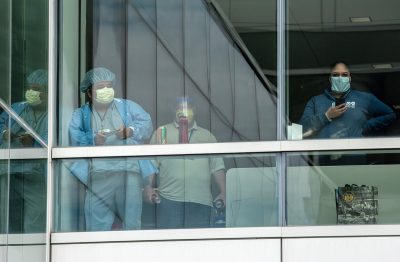A cluster of COVID-19 identified on Sept. 22 at Brigham and Women’s Hospital has infected dozens. Brigham and Women’s Hospital confirmed 45 cases related to the cluster as of Wednesday.

Twelve patient and 33 employee cases have been linked to the cluster. On Wednesday, the hospital announced an additional positive test, a patient whose case has not been linked to the cluster.
Brigham and Women’s Infection Control team believes the cluster has been contained in two inpatient units, both located in the Braunwald Tower section of the hospital, according to a press release.
“Our Infection Control team is investigating the source of the cluster through intensive contact tracing, testing, and staff interviews,” Brigham and Women’s Hospital stated. “Those individuals who have been exposed have been contacted directly and we have facilitated testing for them.”
Brigham and Women’s Hospital is testing current inpatients every three days for COVID-19, as are staff members potentially exposed to the cluster who are in the highest-risk groups.
While the hospital has not determined the source of the cluster, Brigham and Women’s Infection Control unit outlined several contributing factors, including cases of patients not wearing masks when interacting with staff and inconsistent use of eye protection by some health care providers. A staff member with “mild symptoms” consistent with seasonal allergies had also continued to work, not realizing they could potentially be related to COVID-19.
Many nurses at Brigham and Women’s are still feeling stress from the first surge in cases this spring, according to Joe Markman, associate director of public communications for the Massachusetts Nurses Association. The Association represents 3,400 nurses and health professionals at Brigham and Women’s and 23,000 across the state.
“There were a lot of really, really sick patients, people who couldn’t see their families, and the nurses were really at their bedside, constantly taking care of them, helping them communicate,” Markman said. “That was a really traumatic experience for a lot of nurses back in the spring.”
Markman added that there is concern about a second surge coinciding with flu season.
Claire O’Connell, a registered nurse at Brigham and Women’s, said staff morale has been low.
O’Connell worked in the hospital’s COVID-19 intensive care unit during the spring surge, which she described as entering a “war zone.” Though she previously worked in the hospital’s burn trauma ICU, O’Connell said she was unprepared for the chaos in the coronavirus ward.
“Everybody worked together very well and was very supportive,” O’Connell said. “But it was very bad, and we just don’t want to see that happen to that degree again.”
O’Connell, who has been at Brigham and Women’s for more than 32 years, is now concerned about the policies in place after seeing the current cluster of COVID-19 cases that have emerged.
“We need to stop doing some of the things we’ve allowed to happen, which is visitor policies,” O’Connell said. “It may come that they have to decrease some of the procedures if they’re not very necessary.”
Concerns about foot traffic, masks and other policies at Brigham and Women’s fueled a public statement put out by MNA members Monday that called for stricter safety measures in the hospital.
The statement requests that Brigham and Women’s returns to safety policies implemented during the initial surge. Demands include providing N95 masks to all nurses and notifying staff when a patient or other staff member tests positive in their hospital unit.
Markman said nurses appreciate the communication the hospital has provided so far and that there have been daily talks between the hospital and MNA leadership.
The hospital’s updates included steps taken to manage the cluster, including testing more than 6,700 employees and testing all patients in the units touched by the cluster, as well as performing “thorough” cleanings of affected areas.
Brigham and Women’s was one of several hospitals to take part in a “Don’t Avoid Emergency Care” public service announcement campaign organized by the Governor’s Office in April. The PSA encouraged patients to seek emergency medical care despite the pandemic.
Some patients remained cautious during the surge due to the nature of COVID-19 and its contagiousness, according to Sam Melnick, chief communications officer at the Massachusetts Health and Hospital Association, of which Brigham and Women’s is a member.
“Stroke care, cardiac care, things along those lines … there was a sharp decrease in people coming into our emergency rooms for those ailments,” Melnick said. “We all know that, just because the crisis arised, that those ailments had not gone away.”
At the UMass Memorial Medical Center, medical clinics and professionals started to see a return in patients seeking care at normal levels in June, according to Mark Manning, the Center’s division director of general obstetrics and gynecology.
“We definitely saw people not coming in during the first surge during March, April and May timeframe,” Manning said. “A lot of the patients we were seeing in June, you could see that things had gone on, their conditions had worsened and they were afraid to come into the emergency departments. They were afraid of getting COVID.”
Since June, however, Manning said those fears seem to have decreased greatly, although patients do now have more options to receive care via telehealth as a result of hospitals ramping up efforts to provide remote services.




